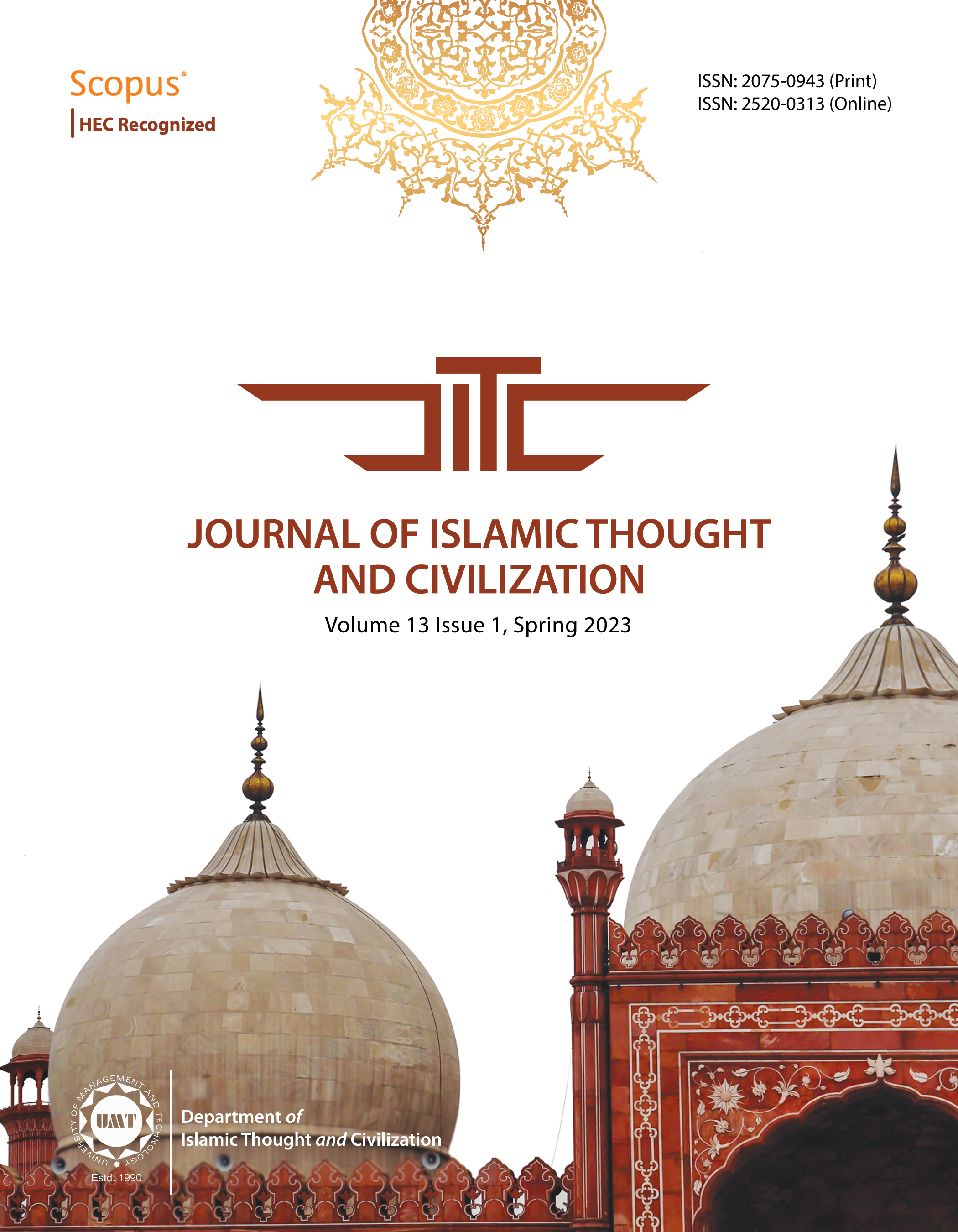Districts of Bangladesh Named After Sufis Manifesting the Great Impact of Sufism on Bengal Civilization: A Qualitative Study
Abstract
 Abstract Views: 93
Abstract Views: 93
Sufism, a mystical Islamic practice, has profoundly impacted Bengal's culture and civilisation, including Bangladesh and the Indian state of West Bengal. The current study aims to discuss how Sufism has helped to reduce religious hatred and extremism among Bengalis. It has also established a system of equality, love, and fraternity among people in the Bengali culture. The history and influence of Sufism in Bangladesh is over a thousand years old and significantly impacts about hundred sixty-nine million people in Bangladesh. One of the reasons is the effect of the calling of Dawah's activities. After Sufism crossed the threshold of Bangladesh, it fascinated the Bengalis and left a meaningful impact on them, which also strengthened their Islamic ideology. Sufism immensely helped the promotion of societal peace in Bengal. The Bengali Sufi saints preached love and compassion, and their ideas also promoted different aspects of religion. They urged people to appreciate variety and value one another's uniqueness. This selfless act inspired many humans to leave their faith to convert to Islam. There is a unique contribution of Sufism to the development of social life and the civilisation of Bangladesh. Remarkably, the settlements of eleven out of sixty-four districts with the names of the famous Sufis show the influence of Sufism. Moreover, since the Sufis were charismatic leaders, their piety, helpfulness, and compassion continue to help Sufism remain a pillar of mystical Islam in Bangladesh.
Downloads
References
Alvi, S., S. (2012). Perspectives on Mughal India: Rulers, Historians, Ulama, and Sufis, Karachi: Oxford University Press.
Asher, C., B. (1984). Inventory of Key Monuments. In the Islamic Heritage of Bengal, Paris: United Nations Educational, Scientific and Cultural Organization (UNESCO).
Ali, A. (1882). A cry for the Indian Mohamedans, Nineteenth Century. New York: Vol, xii. A.D.
Ahsan, A. (1994). Spread of Islam in pre-Mughal Bengal, Dhaka: Intellectual Discourse.
Bahauddin, M. (2016). "Sufism in Bangladesh," Dhaka: Daily Samakal editorial, Retrieved December 24, 2020. https://samakal.com/todays-print-edition/tp-islam-society/article/1610245583
Battuta, I. (1953). Rehla of Ibn Battuta. Translator: Mehdi Hüseyin, Baroda: Oriental Institute, p. 46.
Blochmann, H. (2003). Contribution to the Geography and History of Bengal. Kolkata: Asiatic Society.
Brannon, I. (1990). Sufis, scholars, and scapegoats: Rashid Ahmad Gangohi (d. 1905) and the Deobandi critique of Sufism, vol. 99.
Chowdury, S. R. H., & Göktaş, V. (2021). A Critical Analysis of Imam Rabbani Ahmad Sirhindi's Doctrines on Sufism. Teosofi: Jurnal Tasawuf dan Pemikiran Islam, 11(1), 93-121.
Choudhury, D. N. (2004). Amader Sufiaye Kiram (A collection of the Life sketch of the Sufis). 2nd Ed. Dhaka: Islamic Foundation Bangladesh.
Chowdury, S. R. H. (2019). “Bangladeş’te Tasavvuf Kültürü ve Temsilcileri”, in Ahmet Cahid Haksever, Tematik Tasavvuf Toplantıları Fikriyat Kişiler Kurumlar, Vol. 2. Ankara: Sonçağ.
Chowdury, S. R. H. (2019). “Bangladeş’te Tasavvufun ve Tarikatların Değerlendirilmesi, Sosyal Gelişimleri ve Oynadıkları rol: Yirmi Birinci Yüzyılda bir vak’a Incelemesi”. Ankara: Ankara University.
Göktaş, V., Hasan, M. M., Chowdury, S. R. H., & İsmailoğlu, M. (2022). Spirituality in the Context of Tablighi Jamaat and its Implication on Muslim Society: The Sufi Perspective. International Journal of Social, Political and Economic Research, 9(1), 49-66.
Göktaş, V., & Chowdury, S. R. H. (2019). Freedom Of Relıgıon, Faıth And Relıgıous Tolerance In Bangladesh: A Case Study On The Islamıc Mystıcısm/Bangladeş’te Din Özürlüğü, İnanç ve Dinî Hoşgörü: İslâm Tasavvufu Üzerine Örnek Bir Araştırma. Disiplinlerarası Sosyal Bilimler Dergisi, (5), 41-67.
Hossain, S., A. (2009) Sufi's contribution to the spread of Islam in Bengal, Dhaka: Daily Manab Zamin, 2017. Retrieved December 27, 2020, http://www.mzamin.com/details-archive2016.php?mzamin=70909
Hasan, P., S. ((2007). The Early Muslim Architecture of Bangladesh, London: I. B. Tauris.
Husain, S., A. (2001). Human Rights in Bengal: Atish Dipankar to Sufis.
Hasan, P. (2007). Sultans, and Mosques: The Early Muslim Architecture of Bangladesh, London: I. B. Tauris.
Hasan, P. (2007). Sultans and mosques: the early Muslim architecture of Bangladesh, I.B. Tauris Publication, pp. 144–147. ISBN 978-1-84511-381-0. Retrieved December 28, 2020.
Haji Shariatullah, Muslim Ummah of North America, Retrieved December 29, 2020.
Hans H. ((2011). Sufism and Saint Veneration in Contemporary Bangladesh: The Maijbhandaris of Chattogram, Routledge Advances in South Asian Studies Routledge: Heidelberg University, 1 edition.
Karim, A., (2007). Social History of the Muslim in Bengal, (2nd ed.), Dhaka: Jatiya Sahitta Prakash.
Mohammad, B. (2017). The relevance of Sufism, Dhaka: Daily Samakal, Retrieved January 3, 2021. https://samakal.com/todays-print-edition/tp-islam-society/article/1701260653
Majumdar, D., N. (1960). and Rao, C. R, Race Elements in Bengal, Calcutta: Asia Publishing House.
Muin U., D., A., K. (1984). History of the Fara'idi Movement in Bengal (1818-1906), Dhaka: Pakistan Historical Society.
Mallick, A., R. (1996). British policy and the Muslims in Bengal 1757-1856, A study of the development of the Muslims in Bengal with particular reference to their education, Dhaka:
Majumdar, R. C. (1990). History of Medieval Bengal, Calcutta: G. Bharadwaj Publication.
Mallick, K. (1998). The Nadia Story, Dhaka: Movement publication.
Mohar, A. (1985). History of the Muslims of Bengal, vol. 1, Riyadh: Imam Muhammad ibn Sa'ud Islamic University.
Nadwi, A., H., A, (2018). Contributions of Muslims to Indian Subcontinents, trans. Muhammad Asif Kidwai, Ankara: South Asian Youth Organization.
Nujrul, A. (2021). Names of districts in the Name of Sufi Saints, thejoban.com, (Access Date: May 2 2022).
Salahuddin, A., C. & Bazlul M., (2004). Bangladesh National Culture and Heritage, An Introductions Reads, Dhaka: Independent University Press.
Schimmel, A. (1975). "Sufism in Indo-Pakistan: Mystical Dimensions of Islam," USA: University of North Carolina Publication.
Sharif, A. (1995). Baul, and Sufi Literature, Dhaka: Anbasha Publishing.
Sharif, A. (2011). Bengali Sufi Literature, Dhaka: Time publication.
Siddiqui, A. (2001). Bangladeshi literature and heritage, Dhaka, Bangladesh, Choyon publication.
Tazeen, M. (1995). Sacred and secular Muslim Discourses (1871-1977), England: Oxford University Press.
Copyright (c) 2023 Vahit Göktaş, Saeyd Rashed Hasan Chowdury

This work is licensed under a Creative Commons Attribution 4.0 International License.

This work is licensed under a Creative Commons Attribution 4.0 International License. Authors retain copyright and grant the journal right of first publication with the work simultaneously licensed under a Creative Commons Attribution (CC-BY) 4.0 License that allows others to share the work with an acknowledgement of the work’s authorship and initial publication in this journal.








